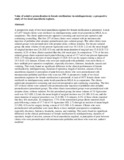| dc.description.abstract | A prospective study of two local anaesthesia regimen for female sterilization is presented. A total of 1,077 female clients were sterilized via minilaparotomy under local anaesthesia (ML/LA) as outpatients. The clients underwent pre-operative screening and received pre-operative and continuing counselling. The first 257 of these clients were sedated with an intramuscular injection of pethidine after atropine premedication (pre-sedated group). The other clients (non-sedated group) were premedicated with atropine alone, without sedation. For the pre-sedated group, the mean volume of one percent lignocaine used was 18.3 (S.D. 2.2) ml, the mean length of surgical incision was 2.8 (S.D. 0.5) cm, and the mean duration of surgical was 15.8 (S.D. 5.3) minutes; 8.2% of these clients reported that they felt much pain. In comparison, 7.7% of the non-sedated group clients reported much pain following a mean of 17.7 ml of one percent lignocaine (S.D. 2.7) through an incision of mean length 2.5 (S.D. 0.5) cm for surgery lasting a mean of 14.5 (S.D. 4.5) minutes. Clients who were pre-medicated with pethidine were more likely to have multiple post-operative complaints, especially dizziness, faintness, headache, nausea and vomiting. This study found no significant difference in the clinical performance of female sterilization by minilaparotomy, duration of operation, length of incision, amount of local anaesthesia required or perception of pain between clients who were premedicated with intramuscular pethidine and those who were not.
PIP:
A prospective study of two local anaesthesia regimens for female sterilization is presented. A total of 1077 female clients were sterilized via minilaparotomy under local anaesthesia (ML/LA) as outpatients. The clients underwent preoperative screening and received preoperative and continuing counseling. The first 257 of these clients were sedated with an intramuscular injection of pethidine after atropine premedication (presedated group). The other clients (nonsedated group) were premedicated with atropine alone, without sedation. For the presedated group, the mean volume of 1% lignocaine used was 18.3 (SD, 2.2) ml, the mean length of surgical incision was 2.8 (SD, 0.5) cm, and the mean duration of surgical procedure was 15.8 (SD, 5.3) minutes; 8.2% of these clients reported that they felt much pain. In comparison, 7.7% of the nonsedated group clients reported much pain following a mean of 17.7 ml of 1% lignocaine (SD, 2.7) through an incision of mean length 2.5 (SD, 0.5) cm for surgery lasting a mean of 14.5 (SD, 4.5) minutes. Clients who were premedicated with pethidine were more likely to have multiple postoperative complaints, especially dizziness, faintness, headache, nausea, and vomiting. This study found no significant difference in the clinical performance of female sterilization by minilaparotomy, duration of operation, length of incision, amount of local anaesthesia required, or perception of pain between clients who were premedicated with intramuscular pethidine and those who were not. author's modified | en |

